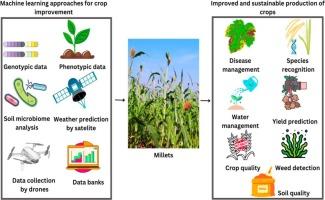Computational interference of gene regulatory networks on the growth and development of millets
IF 1.6
Q3 GENETICS & HEREDITY
引用次数: 0
Abstract
Millets are among the cereal crops cultivated for nutrient-rich food. They are generally considered as resilient crops in terms of growth requirements, as they can withstand harsh climatic factors such as unpredictable climate change and nutrient-depleted soils. The present review highlighted that gene regulatory networks are rewired to control the adaptable traits and to understand the transcriptional regulatory system against environmental stress. By combining machine learning, predictive modeling, and multi-omics data to unravel intricate regulatory relationships, computational methods have entirely changed the study of GRNs (gene regulatory networks), making and identifying important transcription factors, co-regulators, and signaling networks. Recent developments in artificial intelligence, systems biology, and bioinformatics have made reconstructing and analyzing millet GRNs, providing new information on blooming mechanisms, nutrient absorption,and drought resistance. Data scarcity, species-specific heterogeneity, and the requirement for high-throughput functional validation. Computational models incorporating transcriptomics, proteomics, and metabolomics help to improve crop improvement by enabling targeted genetic alterations and increasing predictive accuracy. This study discusses critical approaches, accessible datasets, and new developments in computational GRN investigations in millets. Deep learning, CRISPR-based gene editing, and synthetic biology in millet research are among the opportunities to develop new genotypes. By using computational methods to gain a thorough understanding of millet GRNs, it will be possible to create millet varieties that are more nutritious and climate-robust, promoting sustainable agriculture.

基因调控网络对谷子生长发育的计算干扰
小米是一种营养丰富的谷类作物。就生长需求而言,它们通常被认为是适应力强的作物,因为它们可以承受恶劣的气候因素,如不可预测的气候变化和营养枯竭的土壤。本文综述了基因调控网络的重新布线,以控制适应性性状,并了解对环境胁迫的转录调控系统。通过结合机器学习、预测建模和多组学数据来揭示复杂的调控关系,计算方法完全改变了grn(基因调控网络)的研究,制造和识别重要的转录因子、协同调控因子和信号网络。近年来,人工智能、系统生物学和生物信息学的发展使谷子grn得以重构和分析,为谷子开花机制、养分吸收和抗旱性提供了新的信息。数据稀缺性、物种特异性异质性以及对高通量功能验证的需求。结合转录组学、蛋白质组学和代谢组学的计算模型通过实现靶向遗传改变和提高预测准确性来帮助改善作物改良。本研究讨论了小米计算GRN研究的关键方法、可访问的数据集和新发展。小米研究中的深度学习、基于crispr的基因编辑和合成生物学都是开发新基因型的机会。通过使用计算方法来全面了解谷子grn,将有可能创造出更有营养、更适应气候变化的谷子品种,从而促进可持续农业。
本文章由计算机程序翻译,如有差异,请以英文原文为准。
求助全文
约1分钟内获得全文
求助全文
来源期刊

Plant Gene
Agricultural and Biological Sciences-Plant Science
CiteScore
4.50
自引率
0.00%
发文量
42
审稿时长
51 days
期刊介绍:
Plant Gene publishes papers that focus on the regulation, expression, function and evolution of genes in plants, algae and other photosynthesizing organisms (e.g., cyanobacteria), and plant-associated microorganisms. Plant Gene strives to be a diverse plant journal and topics in multiple fields will be considered for publication. Although not limited to the following, some general topics include: Gene discovery and characterization, Gene regulation in response to environmental stress (e.g., salinity, drought, etc.), Genetic effects of transposable elements, Genetic control of secondary metabolic pathways and metabolic enzymes. Herbal Medicine - regulation and medicinal properties of plant products, Plant hormonal signaling, Plant evolutionary genetics, molecular evolution, population genetics, and phylogenetics, Profiling of plant gene expression and genetic variation, Plant-microbe interactions (e.g., influence of endophytes on gene expression; horizontal gene transfer studies; etc.), Agricultural genetics - biotechnology and crop improvement.
 求助内容:
求助内容: 应助结果提醒方式:
应助结果提醒方式:


